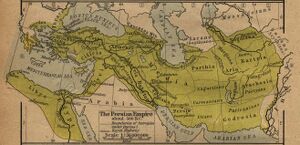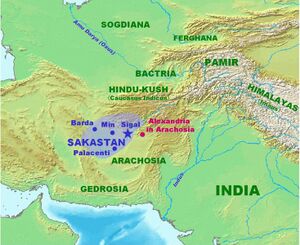Sogdiana


Sogdiana was the ancient civilization of an Iranian people and a province of the Achaemenid Empire.
Variants of name
- Sogdia
- Suguda (Old Persian)
- Sogdiana
- Σογδιανή (Ancient Greek),
- Sogdianē
- Soġd (Persian)
- Tajik: Суғд, سغد Suġd;
- Uzbek: Sơģd;
- Chinese: 粟特 Sùtè)
Jat clan
- Sogaria
- Solanki: P.C. Bagchi in, “India and Central Asia” says that the Sulikas are originally from Sogdiana in Central Asia, and came to settle in India. [1]
History
It is eighteenth in the list on the Behistun Inscription of Darius the Great (i. 16). Sogdiana is "listed" as the second of the "good lands and countries" that Ahura Mazda created. This region is listed second after Airyanem Vaejah, "homeland of the Aryans", in the Zoroastrian book of Vendidad, indicating the importance of this region from ancient times.[2] Sogdiana, at different times, included territories around Samarkand, Bukhara, Khujand, Panjikent and Shahrisabz in modern Tajikistan and Uzbekistan.
The inhabitants of Sogdiana were the Sogdians, an Eastern Iranian people who are among the ancestors of modern-day Tajik, Pashun and Yaghnobi peoples.
The Sogdian states, although never politically united, were centered around the main city of Samarkand. Sogdiana lay north of Bactria, east of Khwarezm, and southeast of Kangju between the Oxus (Amu Darya) and the Jaxartes (Syr Darya), embracing the fertile valley of the Zeravshan (ancient Polytimetus). Sogdian territory corresponds to the modern provinces of Samarkand and Bokhara in modern Uzbekistan as well as the Sughd province of modern Tajikistan.
An independent and warlike Sogdiana[3] formed a border region insulating the Achaemenid Persians from the nomadic Scythians to the north and east. The Sogdian Rock or Rock of Ariamazes, a fortress in Sogdiana, was captured in 327 BC by the forces of Alexander the Great; after an extended campaign putting down Sogdian resistance and founding military outposts manned by his Macedonian veterans, Alexander united Sogdiana with Bactria into one satrapy. The military power of the Sogdians never recovered. Subsequently Sogdiana formed part of the Hellenistic Greco-Bactrian Kingdom, founded in 248 BC by Diodotus, for about a century. Euthydemus I seems to have held the Sogdian territory, and his coins were later copied locally. Eucratides apparently recovered sovereignty of Sogdia temporarily. Finally the area was occupied by nomads when the Scythians and Yuezhis overran it around 150 BC.
External links
References
- ↑ 160-op.cit.p.146
- ↑ AVESTA: VENDIDAD (English): Fargard 1.
- ↑ Independent Sogdiana: Lane Fox (1973, 1986:533) notes Quintus Curtius, vi.3.9: with no satrap to rule them, they were under the command of Bessus at Gaugamela, according to Arrian, iii.8.3.

